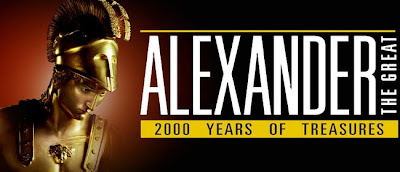 |
| Alexander the Great exhibition poster |
The objects were sent in three shipments, each taking over three days to reach Sydney by air, with much of the road route overseen by police escort. A group of 29 curators and conservators accompanied the pieces on the journey. Dr Anna Trofimova, the Hermitage's Head of Classical Antiquities, working alongside Professor Dr Mikhail B. Piotrovskjy, Director, State Hermitage Museum, has brilliantly curated the exhibition.
It is organised around six major themes:
• The myth of Alexander
• Alexander’s background
• Alexander's Eastern campaign
• The Hellenistic cultural legacy created by Alexander’s empire
• Ongoing Hellenistic influences
• Reinventing Alexander
 |
| The exquisite 3rd century BC Gonzaga cameo |
Alexander in Uzbekistan
Alexander and his armies marched through much of Central Asia. Today, many blue eyed Uzbeks will tell you their ancestors were soldiers from his armies. He is not, however, known in the region as 'The Great'. Either you will hear him referred to as Alexander of Macedonia (Александр Македонский) or Iskandar Zulqarnay (Iskandar is the Persian for Alexander and Zulqarnay means 'two horns', from coinage depicting him with two ram's horns).
In 329 BC Alexander conquered Samarkand, then known as Marakanda. Marakanda was the base of fierce resistance to Alexander. Indeed the local Sogdians, led by the hero Spitamen, significantly delayed Alexander's eastern campaign. Although Alexander had said “Everything I have heard about Marakanda is true. Except that it is more beautiful than I ever imagined,' this did not stop him sacking the city. Marakanda was also the place in 328 BC where Alexander killed his childhood friend, Cleitus, (who had once saved his life), following a drunken dispute.
 |
| Alexander kills Cleitus, painting by Castaigne |
Alexander in Kyrgyzstan
The earliest notable residents of what is now Kyrgyzstan, from about the 6th century BC to the 5th century AD, were Scythians. Excellent warriors, the Scythian tribes in the far west resisted the invasion of Alexander's troops in 328-27 BC.
The vast tracts of woodland with nut and fruit trees in the valley of the Arslanbob river are the largest of their kind in the world, measuring over 600,000 hectares. A legend states that Alexander once led his troops to these parts. Here, it is said, he completed his campaign to the east and decided to return home. He took with him fruits and nuts grown in the forests. And that is how the walnut from the Kyrgyz Mountains appeared in Greece: it has since been known as the 'Greek nut' (Gretski) in many parts of the world.
Do catch the Sydney exhibition. We are incredibly lucky to have a chance to visit this collection. View details on the Australian Museum's website.
Related posts:
Buddhist Sites of Termez, Uzbekistan
The Ancient Site of Afrosiab, Samarkand
Merv, an Ancient Silk Road Oasis in Turkmenistan
The Greek Community of Uzbekistan